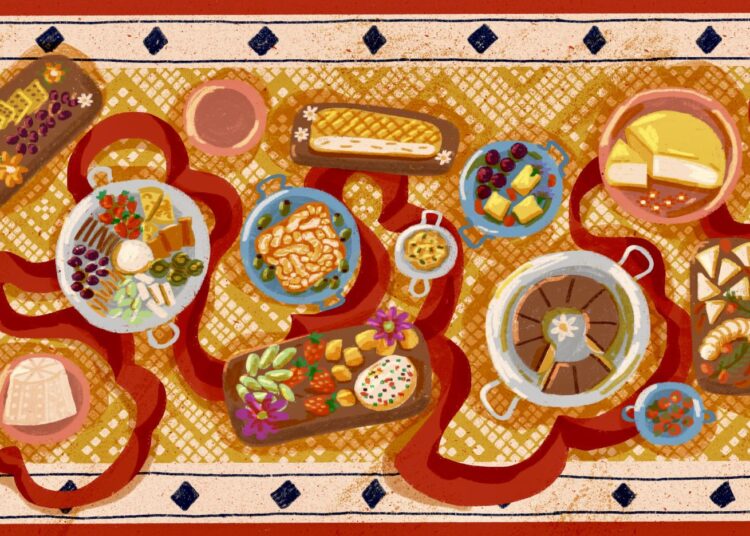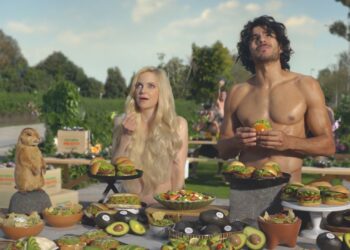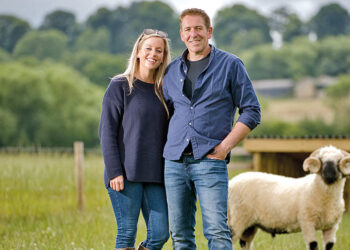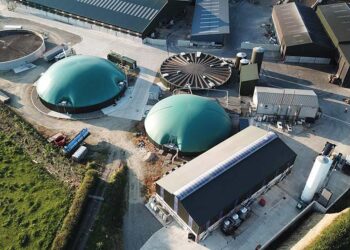Sonny Ross
India’s artisan cheesemakers are pushing boundaries, shaping palates, and celebrating the country’s traditional dairy practices
Creamy, tart, and friggin’ delicious: The pineapple cheese sandwich at Manek Sandwich is a thing of beauty. Three slices of crustless white bread with butter, layered with pyramids of grated processed Amul cheese, pineapple jam, vanilla ice cream, and a ring of canned pineapple, and finished with a flourish of grated cheese for good measure, it’s gone in 60 seconds.
Located in Ahmedabad, the largest city in the Indian state of Gujarat, owner Imtiaz Sheikh’s stall sells thousands of these umami flavor bombs to hungry customers in Manek Chowk, a jewelery market that transforms into a vegetarian street food extravaganza every evening. As exciting as these little bites are, Manek Sandwich’s popularity is not an anomaly: Whether it’s cheese spinach dosas at street food stalls or the paneer butter masala recipe videos on YouTube with 12 million views, cheese and its many iterations are beloved across India. This should come as no surprise when you consider that the country is the largest producer of milk in the world, accounting for 24 percent of the globe’s total milk production.
India loves cheese, but the mass-produced cubes and slices that go into kiddie lunch boxes and are grated over street food are hardly quality products. That’s now changing slowly but surely, thanks to a new generation of artisanal cheesemakers who are pushing boundaries, helping Indians rediscover the country’s traditional dairy practices and appreciate homegrown products — and winning prestigious international awards while they’re at it.
Last November, Eleftheria, a Mumbai-based fromagerie, won big at the World Cheese Awards in Norway when its Brunost, a Norwegian-style whey cheese, was ranked among the top five cheeses in the world, earning a Super Gold for its toffee hue and velvety finish.
“I wanted the Brunost to be perceived as good, and not just as good enough for a cheese coming out of India,” says Mausam Narang, Eleftheria’s founder. Eleftheria’s Konark, a rustic, French-style Tomme, also took home a gold at the competition. Since she founded Eleftheria in 2015, Narang has attempted to demystify cheese for Indian diners by including familiar references in her lexicon: her Konark cheese wheel, for example, gets its name from the chariot wheel carved into the Konark temple in the Indian state of Odisha. “The idea is to make cheese as accessible as possible, and take it far away from the intimidating nature that most craft products have,” Narang says.
Since the World Cheese Awards, Narang has seen an uptick in business among different audiences: young parents looking for a quality product for their kids, wedding planners who want something unique to send along with their invites, and hotels and restaurants who are now serving the cheese at their breakfast buffets. “The biggest shift I’ve seen in the recent past is that among urban consumers, artisanal cheese has become a part of their daily lives instead of being relegated to occasion-based eating,” Narang says. “So instead of cheese platters at parties, people are using our cheese in chile cheese toasties, shaving it over pasta, and even using it in Indian dishes. That’s a real sign that we’ve been able to penetrate the market well.”
While the concept of artisanal cheese in India is relatively new, cheesemaking itself has deep roots here. The country’s relationship with dairy is one that goes back centuries, churned with layers of cultural and religious mythologies, colonization, and foreign trade.
Many believe cheesemaking was originally brought to India in the 16th century by the Portuguese. But in 2020, an independent study published in the science journal Nature traced South Asia’s earliest evidence of cheesemaking to the mid- or late third millennium BCE, based on archaeological finds from the Kotada Bhadli settlement, located in Gujarat’s modern-day Kutch district. The study posits that it was natural for nomadic dairy tribes to ferment and preserve dairy products, which in turn gave rise to local cheese varietals.
In the mid-’70s, India’s earliest artisan cheesemakers launched products like Gouda and mozzarella to little fanfare. While the cheeses were popular in the regions where they were manufactured, they rarely made it to plates beyond. In the last five years, however, the artisanal cheese industry has gained significant momentum due in large part to the pandemic-induced lockdowns, which forced (mostly urban) consumers and retailers to explore indigenous options. According to an estimate by the market research firm IMARC Group, India’s cheese market touched 88.9 billion rupees in 2023 and is expected to grow to 512 billion rupees by 2032. According to a 2023 report by Käse, a Chennai-based cheesemaker, the country has less than 30 artisanal cheesemakers, of which just four have managed to scale up enough to sell their products nationally.
Käse is one of them. When the fromagerie launched in 2016, its founders had to spend a considerable amount of time and effort educating consumers about the kinds of cheese they were making. “Back then, customers knew cheddar, feta, mozzarella and burrata, but not much beyond that,” says Käse co-founder Namrata Sundaresan. “Now, people call to inquire if the vegetarian rennet in our cheese is microbial or plant-based. That’s a sea change in customer awareness.”
Sundaresan, who runs Käse with her business partner Anuradha Krishnamoorthy, is also a trainer at the Academy of Cheese, a nonprofit organization that promotes cheese education, while Krishnamoorthy has a background in social ventures. Together, they work with camel, sheep, and goat milk sourced from tribal farmers to produce cheeses such as Tomme, pecorino fresco, and Greek feta. A couple years ago, Käse helped set up Panchal Dairy, an entrepreneurial initiative by the youth of the Maldharis, a pastoral community in the Gujarati city of Sayla. Panchal now sells fresh goat cheese, aged goat cheeses like Tymsboro and St. Marcellin, and speciality sheep milk cheeses like manchego and Roquefort, all flavored with local milk. Both their Alpine-style washed-rind cheese and aged, semi-hard milled curd cheese have won medals at the World Cheese Awards.
Käse’s work with local tribal farmers is characteristic of the drive many artisanal cheesemakers have to put a distinctive stamp on their work, and to create opportunities in the process. “I’ve made cheese with milk from Gir cows [a native Indian cow from Gujarat] versus Holstein Friesian cow milk and there’s a sea of difference,” Eleftheria’s Narang says. “We buy goat milk from a small farmer in Maharashtra who allows his goats to free-graze across the plains. That translates into stunning cheese. So the more cheesemakers we have, the more the supply chain gets paid and the more farmers are going to be incentivized to produce good quality milk, which in turn can make good-quality cheese.”
Using local milk also speaks to more existential considerations. “The question many of us in the cheese industry in India have been asking is, ‘What really is Indian cheese?’” Mansi Jasani says. A cheese educator and monger based in Mumbai, Mansi is the only Indian to be a part of the World Cheese Awards Super Jury (which judges the competition’s highest-ranking cheeses), and the first Indian to be inducted into the La Guilde Internationale des Fromagers, a nonprofit organization that promotes and connects the work of cheese professionals around the world.
“The simple answer to that question is that the definition is largely indicative of ingredients and terroir,” Jasani says. “This brings us to another question. If we’re following a Gruyere recipe in India, is it really Gruyere? Shouldn’t we have our own unique names that are representative of our cheese culture?”
As Eleftheria’s Konark suggests, some Indian cheesemakers are getting creative with names. At the Farm, an integrated urban dairy farm located on the outskirts of Chennai, the manchego-style cheese is called Queso Coromandel, a nod to farm’s location in the subcontinent’s southeastern coastal region. Using high-fat buffalo milk from their dairy, the Farm produces a buttery, nutty Spanish-style cheese whose flavor sings of the land it comes from.
Spice blends are another way that Indian cheesemakers are infusing national identity into their products to better appeal to their urban customer base. Käse’s Ode to Chennai has a coating of molaga podi, a spicy powdered condiment made from dry red chiles. In Uttarakhand, located at the foothills of the Himalayas, the Darima Farms Zarai cheese is flavored with a local spice and oil rub that has a pronounced cumin flavor.
The language used to describe cheese is also important: Instead of umami, the catchall Hindi word “chatpata” is now being used at cheese tastings to describe the multilayered flavors that have something in common with those found in Indian snacks such as chaat. Context matters, too: At Eleftheria, the social team has been hard at work creating recipes that incorporate ’90s Indian nostalgia, such as one that combines salty Monaco biscuits with strawberry preserves and the company’s creamy brie.
While cheesemakers like Käse report significant growth during the pandemic, driven by urban India’s cheese lovers, they’re also happy to report that retail demand has almost tripled since then. “More and more Indians are realizing not just the cost benefit of homegrown artisan cheeses over international counterparts, but also the taste benefit,” says Sunderesan, referring to how artisanal Indian cheeses cater to local salt-loving palates and keep in mind the region’s cuisine and affinity for spice. In the last five years, India’s average per capita cheese consumption has grown from about 300 grams to 1.4 kilograms annually, according to industry estimates. While this pales in comparison to consumption patterns of cheese in the U.S. (an annual 19.5 kilograms per person), the sheer magnitude of India’s population makes it significant.
The country’s artisan cheesemakers have found another path to success via the hotel and restaurant industry. “Instead of chefs buying mozzarella that travels from Italy to India and sits for a few days at the airport to get cleared by customs, they can now access fresh cheese of the same terroir they’re from. This is leading to all kinds of exciting innovations,” says Aditya Raghavan, a physicist-turned-cheese consultant who has helped a few fromageries across India set up shop.
Driven by the increase in customer demand and a growing supply of quality homegrown cheese, more chefs across India are exploring the country’s dairy traditions. A few years ago, Manu Chandra, a CIA-trained chef and entrepreneur, launched a tiny but noteworthy cheese cave in the heart of traffic-ridden Bengaluru, located in the south of India. The result is Begum Victoria, a label whose cheeses are now found at some of India’s top hotels and restaurants and whose creamy brie and buttery Bel Paese are fast becoming industry favorites.
Chandra is one of India’s most prominent chefs — on social media, he is fondly referred to as the country’s answer to Emily in Paris’s chef Gabriel — and his association with the label has boosted the broader appeal of artisan cheese for many diners. At Chandra’s restaurant Lupa in Bengaluru, informal cheese tastings are not uncommon, and the best-selling appetizer is Begum Victoria’s creamy brie served bubbling hot topped with fig jam, toasted walnuts, and fresh herbs.
But making artisanal cheese in India’s tropical climate comes with its own fair share of challenges. Here, the yield on artisanal cheese production in an aged format is only 10 percent, owing to the country’s humid, tropical climate. “If I start with 500 liters of milk, I’m only going to get five kilos of cheese,” Chandra says. “When you put it in a natural cave to age, you’ll lose another 10 to 15 percent. And then you’re going to cut it open and lose 10 to 15 percent of that. Forget angel’s share, this is completely nuts!”
But this is exactly where the chef sees a huge opportunity. “Excessive aging is not necessarily beneficial to Indian craft cheese owing to our climate,” he says. “But you can create a very similar product in much shorter periods of time.” To maximize Begum Victoria’s output, Chandra uses the trimmings of the cave-aged and ripened cheese from the cave to create Daily Duty, a processed cheese with provenance. “India needs a good alternative to the generic cheese that’s flooding the market and the Daily Duty makes for an excellent grilled cheese,” Chandra says. “It is still artisanal cheese, yes. But India is a scale game so even if you ratchet this up by one to two percent, it’s a big market.”
When it comes to local preferences, fresh cheeses like cheddar, mozzarella, and burrata are driving sales across India’s artisanal cheese market. But the ones that truly shine are, sadly, unlikely to make a dent abroad, owing to stringent international laws around raw and fresh milk cheeses exported from developing countries. “Due to EU guidelines, cheese made with raw milk from countries like Mexico and Brazil could not participate” in last year’s World Cheese Awards, says Mansi, who was one of the judges. While those in India’s artisanal cheese industry harbor dreams of expanding beyond its geographical boundaries, bilateral trade laws, expensive cold chain logistics, and education prove to be a challenge. And yet, in the face of these obstacles, India’s artisans remain dedicated.
Perhaps it’s time for a less Eurocentric understanding of what cheese is in order to fully appreciate the food product as a result of the people, produce, and stories of a region. The future of India’s cheese movement lies somewhere between the critically acclaimed Indian cheeses that international judges and consumers taste, and the livestock farmers deep in the heart of rural India who turn the milk from their animals into sustenance. It’s a food that tells the story of a country and its traditional communities, fighting to stay alive and relevant in a rapidly changing world.
Smitha Menon is a Mumbai-based food & travel journalist, India’s only 50 Best Tastehunter, and the host and creator of the Big Food Energy podcast. Follow her on Instagram @smitha.men.
Sonny Ross is an illustrator based in Manchester, U.K. They love drawing food as much as cooking it but not as much as eating it. They work across editorial, publishing, textiles and packaging and in their downtime enjoys such hobbies as: sleeping.














